
 |
|
|
#1 |
|
All the news that's fit to excerpt
Name: newsie
Location: who knows?
Join Date: Jun 2008 Motorcycle(s): only digital replicas Posts: Too much.
|
[motorcycle.com] - Motorcycles and Hearing Loss
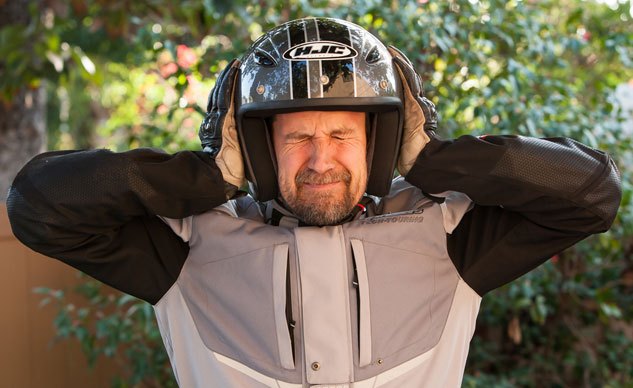 In terms of rider education and injury prevention, a great deal of attention is paid to motorcycle safety by the government, motorcycle industry, and media. However, the subject of hearing loss among motorcyclists is rarely discussed. Yes, riders sometimes make passing remarks about ear fatigue after a long day in the saddle, and recent years have (in my subjective opinion) shown an increase in earplug use among riders. Still, the subject and the use of actual, provable scientific numbers have been relatively overlooked when compared to safety items like body armor and helmets. Roughly one out of every 10 Americans suffer from hearing loss that affects their ability to understand normal conversation. The most common kind of hearing loss is the exposure to excessive noise, and the simple act of riding a motorcycle puts riders at risk for becoming part of those statistics. The wind noise at highway speeds can expose motorcyclists to sound levels in excess of 100 dB – that’s the equivalent of using a chain saw or standing in the middle of a dance club. Helmetless riders can experience noise 10 times greater than that, resulting in potential hearing loss in as little as 30 minutes. Hopefully your rides last longer than a half-hour. According to the National Institute on Deafness and Other Communication Disorders, approximately 15 percent (26 million) of Americans between the ages of 20 and 69 have high frequency hearing loss due to exposure to loud sounds or noise at work or in leisure activities. When we consider hearing loss, we need to keep two things in mind. First, noise-induced hearing loss (NIHL) is preventable. Second, NIHL is permanent. Once that hearing is gone, it’s gone forever. NIHL in the workplace has been well documented, and OSHA has made rules regarding what is an acceptable duration of exposure to various levels of noise. Using these standards as a baseline, riders can learn what the relative intensity of noise they’re facing when they ride and make educated decisions on how to minimize their long-term risk for hearing loss. However, before we delve in to motorcycle-specific causes of NIHL, we should look at the physical causes of hearing loss so that we understand how noise damages our hearing. Hear Ye, Hear Ye! 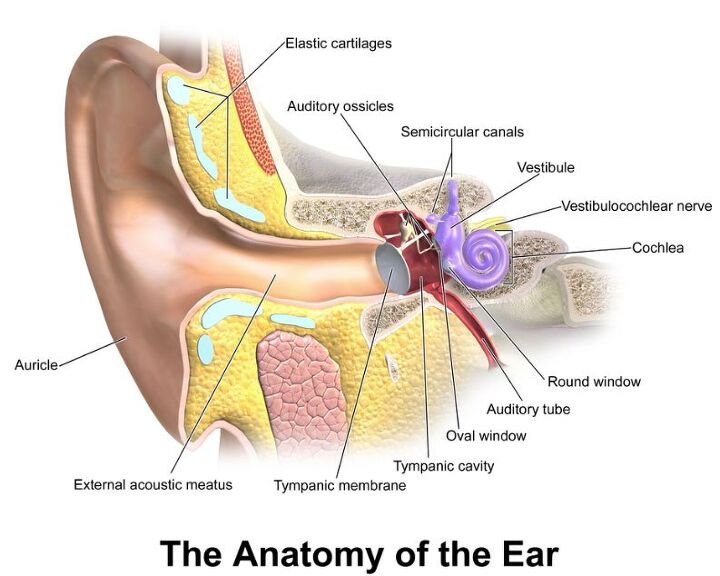 The human ear is an incredibly compact and complex structure, providing riders with vital information. (Credit: Bruce Blaus) The human ear is an incredibly compact and complex structure, providing riders with vital information. (Credit: Bruce Blaus)In the ear, the air pressure waves that are the physical embodiment of sounds are converted by the ear into the electrochemical impulses that the brain can understand. Sound waves travel through the outer ear (the pinna, the part that looks like a funnel) into the auditory canal. At the end of the canal, the eardrum (tympanic membrane) converts the air pressure waves into vibrations that are, in turn, transmitted via three tiny bones (ossicles – commonly referred to as the hammer, anvil and stirrup). Finally, the vibrations reach the cochlea (a fluid-filled bone structure consisting of a tapered tube that wraps around itself similar to a snail’s shell) where the vibrations are converted to a form that can be sent to the brain via the auditory nerve. This is where the magic – and damage – takes place. The basilar membrane is one of the membranes dividing the cochlea’s tapered tube lengthwise into three parallel, fluid-filled tubes. The sound vibrations run down the basilar membrane causing hair cells (cilia) in the organ of Corti to vibrate. These delicate hair cells are responsible for making the connection to the auditory nerve by converting the physical vibrations into electrochemical signals. We’re born with about 15,000–20,000 of these cilia, and since we don’t grow new ones when they are damaged, we need to make the cilia last a lifetime. Noises that are too loud damage and ultimately can kill the hair cells. The amount of damage that occurs is time dependent and related to the intensity of the sound. While an extremely loud noise, like an explosion, can cause immediate, permanent damage, extended exposure to less loud but still damaging noise can also lead to permanent damage. Our goal, as motorcycle riders, is to determine the sound threshold that will allow us to take the long rides we enjoy and still be able to talk to our friends and family when we get home. In the Wind 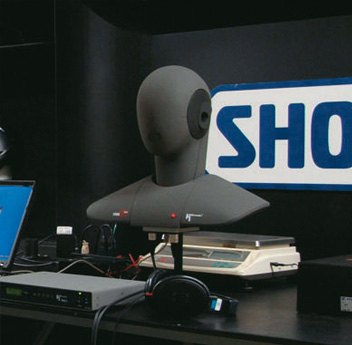 Head forms like this are used in testing for wind noise in helmets. Head forms like this are used in testing for wind noise in helmets.We’re all aware that motorcycles have an image problem with the non-riding public. When they think about motorcycles, they generally think about loud pipes echoing through their neighborhood. However, loud pipes aren’t the primary culprit when it comes to NIHL among motorcyclists. At a stop and at low speeds, we can cause our own hearing loss – I’m looking at you unbaffled V-Twin riders – but once the speed approaches 40 mph, wind noise becomes the dominant sound, especially so for unhelmeted riders. The noise that motorcyclists hear at highway speed is largely a function of turbulence. Recent studies have shown that the primary source of helmet turbulence – and noise – is in the chin bar of a full-face helmet. When these results were initially announced, the anti-helmet lobby latched on to the idea, saying it proved that helmets were bad for riders. However, if one considers the relative aerodynamics of the human head with its ears flapping out in the breeze versus the smoother, more aerodynamic shape of a modern full-face helmet, the fallacy of this argument is readily apparent. An aside: Some studies have shown that certain helmet shapes and construction may amplify sounds of certain frequencies, which is not a good thing and may contribute to hearing loss. However, when compared to the full-on auditory assault of riding helmetless, using this factor as an excuse for not wearing a helmet is nothing more than a straw-man argument. Levels of Noise dBExample140Fireworks, gunshots, jet engine at 100 ft.130Jackhammer, fire truck siren120Jet during takeoff, pnuematic rivetter, thunderclap110Rock concert, car horn, jet flyover at 1000 ft.100Operating a gas lawnmower, MP3 player at full volume90Food blender at 3 ft., power tools, hair dryer80Diesel truck passing by, garbage disposal70City traffic, vacuum, lawn mower at 100 ft.60Normal conversation, workday in business office50Moderate rainfall, dishwasher in next room40Quiet theater or library30Whisper, rural nighttime20Leaves rustling, broadcast studio10Barely perceptible0Threshold of human hearingWhatever you do or don’t have on your noggin, riding a motorcycle at highway speeds is a noisy undertaking. As noted before, extended exposure to loud noises will damage hearing. OSHA standards for noise exposure provide a means of gauging potential damage. Sound intensity is measured on a logarithmic scale. Decibels (dB) start a 0 dB for the quietest sound that can be heard and goes up from there with the threshold of pain being around 130 dB. When a sound becomes 10 dB louder, it is 10 times louder. A 20 dB change is 100 times louder, and 30 dB is 1000 times louder. OSHA has defined 85 dB as the intensity beyond which there is the potential for permanent damage to your hearing. In other words, the longer you listen to sounds above 85 dB, the more cumulative damage you will suffer. From there a sliding scale has been developed to define what duration is safe exposure to noise based on its intensity above 85 dB. Hearing loss from overly loud sounds presents itself in a couple ways. First, temporary threshold shift is the short-term loss of hearing after exposure to loud noise. Think of this as the cup over your ears feeling you had for a few hours after a loud concert. As the name implies, this is a temporary symptom, but doing it repeatedly can cause permanent damage. The second presentation of hearing loss is the permanent damage this article is addressing. OSHA Permissable Noise Exposures Sound Level in dBSafe Duration in Hours9089269549731002105111030 minutes11515 minutesPut a Sock in It Wearing earplugs while riding is the best means of preventing NIHL. Riders have several options which offer various levels of protection, comfort and convenience. The range of cost goes from less than a dollar a set to over $100 for custom molded items. 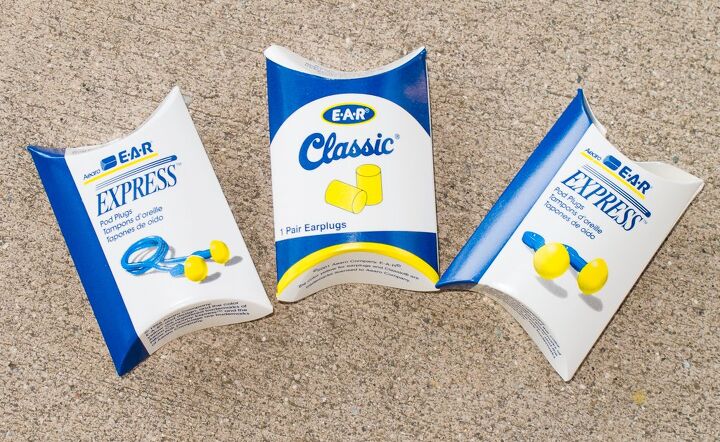 Look around the offices of almost any motorcycle publication, and you’re likely to find a bulk dispenser of foam earplugs. They are inexpensive and effective for the majority of riders. Look around the offices of almost any motorcycle publication, and you’re likely to find a bulk dispenser of foam earplugs. They are inexpensive and effective for the majority of riders.The cheapest and most common ear protection is foam earplugs which can be found at any local drug store. Foam earplugs come in a variety of shapes, from cylinders to tapered to bullet-shaped, but you insert them the same way: roll them into a tight cylinder and slide them into your ear before they expand. When installed correctly, foam earplugs can effectively reduce noise to a level to allow all-day riding without any hearing damage. All brands of non-custom earplugs are required to include a Noise Reduction Rating (NRR) on their packaging. Claims of 32dB sound reduction are common with foam. When they get dirty – and they will – simply throw them away and open another package. However, be forewarned, proper installation of foam earplugs is required for anything close to the NRR protection. People with narrow or oddly shaped ear canals will find that the softness that makes these plugs so comfortable to wear also makes it extremely difficult to get them completely inserted – grabbing the top of the ear and pulling it up and back is key to getting them fully implanted. Another feature of foam plugs that some riders don’t appreciate is how they muffle high-frequency sounds more severely than low, which can make conversations difficult. On the plus side, the high-frequencies are the first to be damaged from excessive noise. 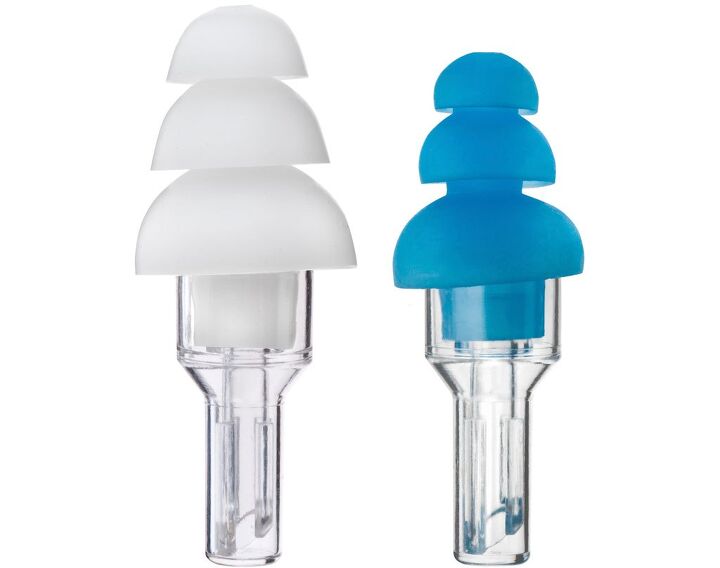 Flanged earplugs like these from Etymotic Research attenuate the sound with a flat frequency response for quieter but still natural sound. Large ear canals are accommodated by the white plug, and small/average sized require the blue for a proper fit. Flanged earplugs like these from Etymotic Research attenuate the sound with a flat frequency response for quieter but still natural sound. Large ear canals are accommodated by the white plug, and small/average sized require the blue for a proper fit.Flanged earplugs are often made of a pliable latex or silicon – although some are made with a foam material. The flanged tips are usually tapered for deep insertion into the ears to gain the required air-tight fit. However, if you have deep ear canals, you may find that you can push the plugs in far enough to make them difficult to remove (as E-i-C Duke did on a recent ride). The construction of these earplugs makes them uniquely tunable.*Some have a solid core that results in the best NRR with similar sound characteristics as foam earplugs, while others have cores that produce more accurate sound reproduction. Since there is no free lunch, the flat response plugs may have a lower NRR rating. (For example, Etymotic Research’s ER–20 have a NRR of 12dB, but the company claims that “actual clinical measurements of properly inserted ER•20s indicate that these earplugs provide almost equal sound reduction (20 dB) at all frequencies.”) You may find this type of earplug from other manufacturers listed as “musician’s earplugs.” Although flange-type earplugs are more expensive than disposable foam ones, they can be reused for extended periods. If they become dirty, they can be easily cleaned. Inserting flange earplugs takes some getting used to. They require a little lubrication (saliva works just fine), and you have to place them fairly deeply into the ear canal. My rule of thumb is to insert them until I get the urge to cough. I’ve worn Etymotic’s ER–20s exclusively for over five years, and have no desire to switch to anything else – unless it would be stepping up to custom molded units. 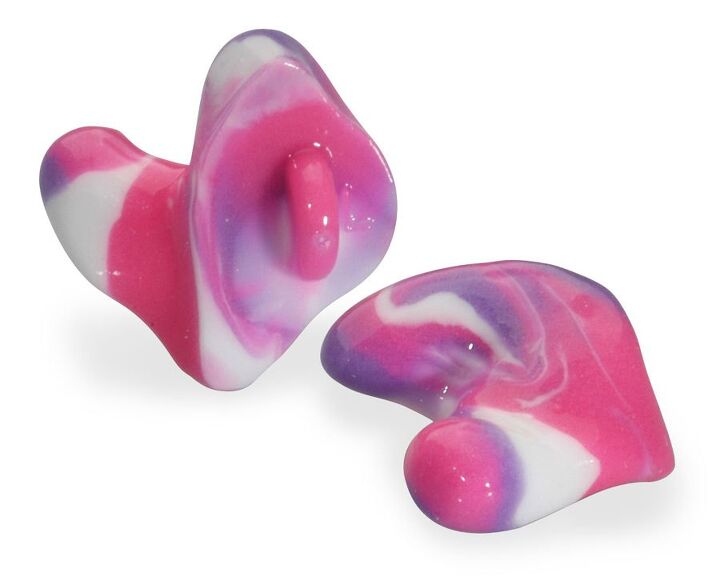 Custom fit earplugs like the these can be bought at many motorcycle events for less than $100. Custom fit earplugs like the these can be bought at many motorcycle events for less than $100.For people who want the ultimate in protection from NIHL, getting custom molded earplugs is the way to go. At many motorcycle events, you may have seen people getting brightly colored goo injected into their auditory canal. Custom earplugs will only fit the unique ear shape of their owner, giving them easier insertion and a perfect fit for maximum attenuation of noise. Like with foam plugs, some people may feel that these solid custom plugs mute the sound too much, making it hard to hear things that riders want to hear, like approaching traffic or conversation at a stop. Turning to earplugs developed for musicians (who require sound to be as accurate as possible) can help riders experience a natural sounding environment at an intensity below the threshold for long-term damage. In fact, some people who have used these plugs report that they actually hear better on the road because their ears aren’t getting overwhelmed by the intensity of the noise. Bringing the sound level down actually allows for the rider to discern the different frequencies of different sounds rather than having their auditory nerves overloaded by a sound soup. 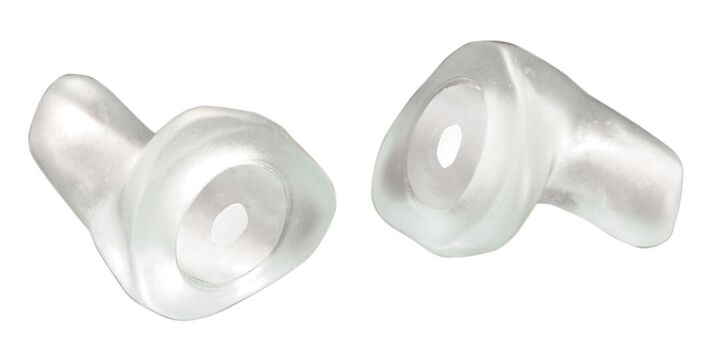 The Etymotic musicians’ earplugs ($150) on the right have replaceable buttons to tune the attenuation from 9–25 dB and require a custom earmold from an audiologist. The Etymotic musicians’ earplugs ($150) on the right have replaceable buttons to tune the attenuation from 9–25 dB and require a custom earmold from an audiologist.Think of our perception of sound as a glass of water. When you try to pour more into a completely full glass, it just runs out. Our ears can’t process any more information. However, if you find a way to lower the level of water (the wind noise), you have room for other sources. Because of their neutral reduction of sound, these specialized earplugs require that an earmold be made by an audiologist. While this process is more expensive than the custom plugs made at motorcycle events, they do allow for multiple copies to be made if you are worried about losing your earplugs. No matter what earplugs you choose, you can take additional steps to reduce the noise that you have to combat. Sometimes, a small adjustment of windshield height will make a huge difference in the way turbulence hits your helmet. Directing turbulence away from the helmet base can pay big dividends. If your helmet has adjustable visor mounts, make sure that they allow the visor to completely seal the eye port. In hot weather, use the helmet vents rather than cracking the visor at speed. Although vents do increase the noise inside a helmet, it is usually significantly less that the noise created with a slightly opened visor. The fit of a helmet around its base can leave gaps between the rider and the liner that allow noise access to the rider’s ears. Consider this fit when buying a new helmet. Also, if a rider has an oval head but chooses a helmet with a round shape, there will be excessive space on the sides that affect both impact and noise performance. Looking Ahead Two areas of research hold the most promise for reducing the noise that motorcyclists experience at speed. The first is fairly obvious. Build helmets that are increasingly designed towards attenuating noise. Although helmet manufacturers are more frequently mentioning the quietness of their helmets – particularly premium models – when unveiling them for the public, until there is an accepted standard for measuring helmet noise, motorcyclists have no way to ascertain which helmets provide the most auditory protection. So, some kind of national or international standard would improve the consumer’s ability to make an educated choice. Steps are being made in this direction since Schuberth makes a specific claim of “85dB(A) at 60 mph (with naked bikes)” for its S2 helmet. Both HJC and Shoei have specifically mentioned wind tunnel testing in an effort to reduce turbulence around the chin bar in recent launches of 2014 helmet models. When asked about wind tunnel noise testing, a representative from Shoei Japan said that, while developing helmets, the company does comparison testing of comparable helmets on the market for internal purposes. In addition, Shoei won’t publish numbers for its own helmets because “as there is no standardized procedure, the results…depend heavily on the conditions of experiment itself (and no one knows what it is, except [the person] who had done the test).” The representative stressed that until a standard for testing is agreed upon, a “comparison between the data which Shoei made and someone else made will be totally meaningless, as the fundamental conditions of the experiments [are] most likely different for each.” With this in mind, it seems clear that both motorcyclists and helmet manufacturers would benefit from the implementation of a noise standard. 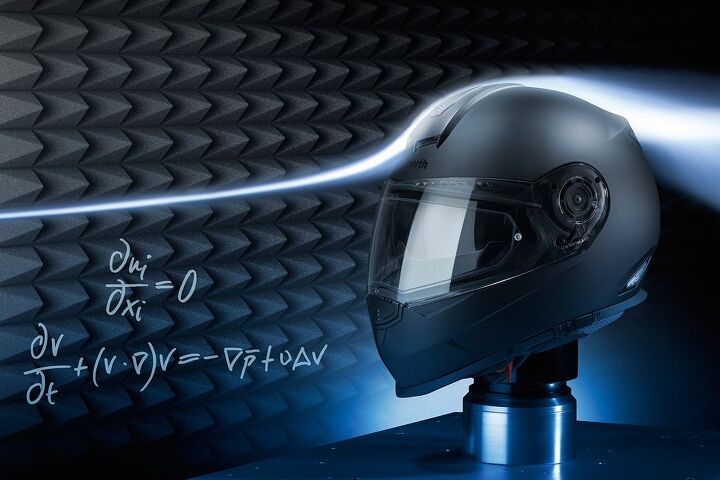 Advances in aerodynamics and establishing noise standards for helmets may hold the key for reducing NIHL. Advances in aerodynamics and establishing noise standards for helmets may hold the key for reducing NIHL.Another area of interest in reducing NIHL for motorcyclists is the development of noise canceling technology. Active noise canceling could come in the form of speakers which use the destructive interference between sound waves to effectively cancel the ambient noise itself. Other passive ways to reduce helmet noise could be retractable ear muffs that form a tight seal over the ear, for protection like you see on airport workers or in shooting ranges. While these developments will be interesting to watch, the best advice we can give riders about how to protect their hearing is to wear earplugs on every ride. Motorcycles and Hearing Loss appeared first on Motorcycle.com. Click here for full story...
__________________________________________________
I'm a bot. I don't need no stinkin' signature... |
|
|

|
 |
 Similar Threads
Similar Threads
|
||||
| Thread | Thread Starter | Forum | Replies | Last Post |
| [ama directlink] - Hearing Notice: U.S. Senate Subcommittee holds hearing on Cape Hat | Ninjette Newsbot | Motorcycling News | 0 | April 22nd, 2013 02:00 PM |
| Hearing loss and buzzing with earplugs!? what to do? | 5evenz | General Motorcycling Discussion | 13 | October 29th, 2011 10:38 AM |
| [topix.net] - Could motorcycle helmets cause hearing loss? | Ninjette Newsbot | Motorcycling News | 0 | August 3rd, 2011 11:50 AM |
| [topix.net] - Why wearing helmets while riding motorcycles can lead to hearing loss | Ninjette Newsbot | Motorcycling News | 0 | July 30th, 2011 10:00 AM |
| [topix.net] - Suzi Perry On Motorbikes & Hearing Loss Inc Video | Ninjette Newsbot | Motorcycling News | 0 | June 29th, 2011 03:10 PM |
|
|